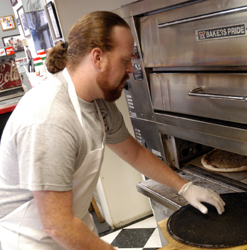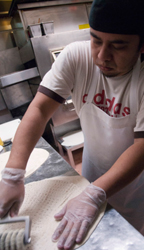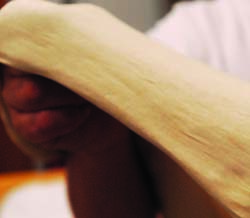
Q: I was recently looking through a catalog that I got at the last Pizza Expo and I saw both wood and metal peels being offered by the different companies. Do you have a preference in one over the other?
A: My preference is to use a wood peel as a prep peel — the peel used to dress the dough and take to the oven. The wood construction typically affords better dough release than the metal peels. The last thing you want to do is to slide a dressed skin into the oven and withdraw an empty pizza skin because it stuck to the peel and slid all the toppings into your oven. This is not to say that the dough will not stick to a wood peel — without dusting flour, the pizza skin can stick quite nicely. It is important to use some dusting flour even with a wood peel, but since wood is a better insulator than metal (aluminum), there is a reduced tendency for the dough to stick to the wood peel (condensation can form under the dough on a metal peel if the dough is warm and the peel blade is cold). I think the metal peel is best reserved for use as an oven peel where it stands up to the everyday “grind” of peel to oven deck/hearth much better than the wood peel does.
With all of this said, do keep in mind that in some localities, the use of wood peels are looked down upon by the local food safety people due to their inability to be properly cleaned and sanitized. This may leave us with only one option, the metal peel, or possibly a peel made from some type of manufactured, composite material that can be easily washed and sanitized without issue. More recently, I’ve had an inspector point to the worn edge of a wood peel and declare that those wood splinters are getting into the pizzas. Right or wrong, we’re in no position to argue with such wisdom, so be sure to give your peel selection more than just a passing thought or you might end up wasting your money on something you can’t use.
Q: We use wood pizza peels to prep our pizzas on and we are required to wash and sanitize them daily. We notice that the peels tend to warp. What can we do to prevent this?
A: While wood peels are not made to be washed, they can be quickly washed and sanitized with a minimum of damage, primarily warping. It is best to start out with a new peel. Wipe it with mineral oil several times to impregnate and seal the wood. This will create a barrier against moisture migration into the peel when washed.
To wash the peel, dip it into the soapy water and scrub gently to remove any debris, then rinse and dip in the sanitizing solution. Next, be sure to wipe the peel as dry as possible with a clean towel, then set aside and allow it to dry thoroughly. This should be followed by another application of mineral oil to reseal the wood. Done carefully, and daily, you can keep problems to a minimum. I have a wood peel that is made from a material that looks a lot like Pakka Wood, a resin wood that is cured under high pressure and heat to form a homogenous wood that is highly stable and moisture resistant. These peels have all of the advantages of a wood peel but without any of the issues.

Photo by Rick Daugherty & Josh Keown
Q: What is your preference for the top of a prep table where we will be hand stretching the dough?
A: That’s easy: just about anything but wood. Dough has a tendency to cling to wood bench tops. This is why bakers like it so much; but for pizza making, we want a top that will allow the dough to slide around easily without sticking or needing an extraordinary amount of dusting flour to prevent it from sticking. I’ve found that for top-end table-tops, marble, or man-made quartz, is hard to beat — but it comes at a price. Lower in cost, and almost equally as effective, is just plain old stainless steel. It has all the appeal of a homely fence post, but it works well and the price is right. Your food safety inspectors will look favorably upon it, too. A lot of your decision as to what to use will boil down to your store concept, and what you want to convey to your customers who might be watching you open your dough into pizza skins as they wait for their pizza to be made before them.
Tom Lehmann is a director at the American Institute of Baking in Manhattan, Kansas.







